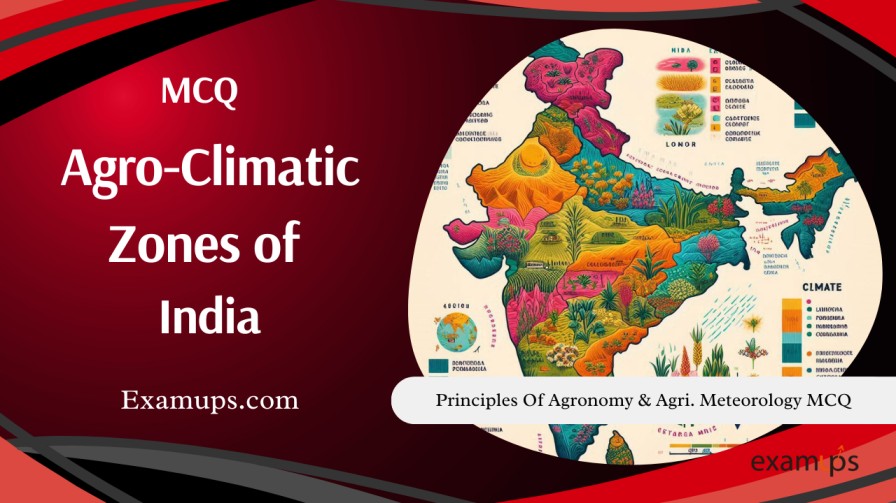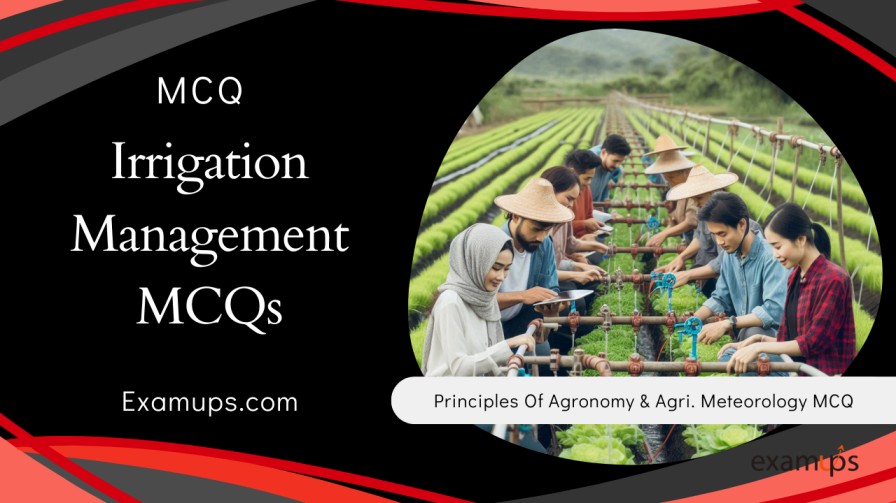Agro-Climatic Zones of India MCQ for All Agriculture Exams like ICAR-JEF, ICAR-SRF, ICAR-NET, IBPS-AFO/SO, Pre-PG, BHU Pre-PG, IFFCO-AGT, CCI, FCI, B.sc, M.sc, etc.
- Which of the following regions is part of the Western Himalayan Region?
- A) Himachal Pradesh
- B) Sikkim
- C) Assam
- D) Bihar
Answer: A
Explanation: The Western Himalayan Region consists of Jammu and Kashmir, Himachal Pradesh, and the Uttar Pradesh hills.
- What are the main soil types found in the Western Himalayan Region?
- A) Alluvial soils
- B) Podsolic soils, mountain meadow soils, hilly brown soils
- C) Red soils
- D) Laterite soils
Answer: B
Explanation: The Western Himalayan Region has various soil types, including podsolic soils, mountain meadow soils, and hilly brown soils.
- Which of the following crops is NOT typically grown in the Western Himalayan Region?
- A) Wheat
- B) Barley
- C) Cotton
- D) Maize
Answer: C
Explanation: Cotton is not typically grown in the Western Himalayan Region; it’s mainly known for crops like rice, maize, millets, wheat, and barley.
- What is the primary method of agriculture in the Eastern Himalayan Region that has led to soil degradation?
- A) Shifting cultivation (Jhum)
- B) Terrace farming
- C) Mixed farming
- D) Organic farming
Answer: A
Explanation: Shifting cultivation, or “Jhum,” is widely practiced in the Eastern Himalayan Region, leading to soil degradation and heavy runoff.
- Which of the following states is part of the Eastern Himalayan Region?
- A) Haryana
- B) Manipur
- C) Rajasthan
- D) Madhya Pradesh
Answer: B
Explanation: The Eastern Himalayan Region includes Manipur, along with other states like Sikkim, Arunachal Pradesh, Meghalaya, Nagaland, Tripura, Mizoram, and Assam.
- What strategy is recommended for land use in the Western Himalayan Region based on slopes?
- A) Land with slopes above 50% is suitable for forestry
- B) Land with slopes below 30% is suitable for agriculture
- C) Land with slopes between 30% and 50% is suitable for horticulture and silvi-pastoral programs
- D) All of the above
Answer: D
Explanation: The recommended strategy in the Western Himalayan Region includes using land up to 30% slope for agriculture, between 30-50% for horticulture and silvi-pastoral programs, and above 50% for forestry.
- Which region has the highest area under forest cover?
- A) Western Himalayan Region
- B) Eastern Himalayan Region
- C) Central Plateau and Hills Region
- D) Coastal Plains Region
Answer: A
Explanation: The Western Himalayan Region has the highest area under forest cover, accounting for about 45.3% of the total area.
- What is a major environmental consequence of shifting cultivation in the Eastern Himalayan Region?
- A) Soil erosion
- B) Soil salinity
- C) Desertification
- D) Decreased soil fertility
Answer: A
Explanation: Shifting cultivation leads to significant soil erosion, causing degradation and heavy runoff, which contributes to environmental challenges in the region.
- Which of the following best describes the cropping and farming systems in the Western Himalayan Region?
- A) High productivity levels in all crops
- B) Low productivity levels in most crops
- C) Intensive commercial farming
- D) Exclusive horticulture
Answer: B
Explanation: The productivity level in the Western Himalayan Region is generally lower than the all-India average for most crops, such as rice, maize, millets, wheat, and barley.
- What would be an ideal infrastructure strategy for the Western Himalayan Region to support agriculture and horticulture?
- A) Development of storage and cold storage facilities for transport, marketing, and processing
- B) Expansion of irrigation systems
- C) Exclusive focus on cash crops
- D) Restricting farming to traditional crops
Answer: A
Explanation: Developing storage and cold storage facilities for transport, marketing, and processing can help support agriculture and horticulture in the Western Himalayan Region, allowing it to meet the demands of the rest of the country.
Question 11: Which region of India is known for its high population density, with a per capita land availability of just 0.095 hectares?
- A) Upper Gangetic Plains
- B) Middle Gangetic Plains
- C) Lower Gangetic Plains
- D) Trans-Gangetic Plains
Answer: C
Explanation: The Lower Gangetic Plains, primarily in West Bengal, have the highest population density among the mentioned regions. The per capita land availability is only 0.095 hectares, indicating limited space per individual.
Question 12: What is the primary crop in the Middle Gangetic Plains, but its productivity is low due to zinc deficiency?
- A) Wheat
- B) Rice
- C) Sugarcane
- D) Maize
Answer: B
Explanation: The Middle Gangetic Plains have rice as the primary crop. However, productivity is low due to widespread zinc deficiency, necessitating technological backup and high-yielding seeds to improve crop yield.
Question 13: Which of the following zones has the highest cropping intensity, reaching 170%?
- A) Lower Gangetic Plains
- B) Middle Gangetic Plains
- C) Upper Gangetic Plains
- D) Trans-Gangetic Plains
Answer: D
Explanation: The Trans-Gangetic Plains have the highest cropping intensity at 170%. This high intensity is due to advanced irrigation practices and high groundwater utilization in Punjab and Haryana.
Question 14: In which Gangetic Plains zone are marine fisheries well developed but in need of better organization?
- A) Lower Gangetic Plains
- B) Middle Gangetic Plains
- C) Upper Gangetic Plains
- D) Trans-Gangetic Plains
Answer: A
Explanation: The Lower Gangetic Plains have well-developed marine fisheries, but there’s a need for better organization to ensure sustainable practices and effective management.
Question 15: Which Gangetic Plains zone suggests using unculturable wasteland for silvi-pasture and agro-forestry?
- A) Lower Gangetic Plains
- B) Middle Gangetic Plains
- C) Upper Gangetic Plains
- D) Trans-Gangetic Plains
Answer: B
Explanation: The Middle Gangetic Plains suggest utilizing unculturable wasteland for silvi-pasture and agro-forestry to optimize land use and promote sustainability in agriculture.
Question 16:
Which zone has high groundwater utilization and a need for diversification in cropping, especially in cultivating vegetables and fruit crops?
- A) Lower Gangetic Plains
- B) Middle Gangetic Plains
- C) Upper Gangetic Plains
- D) Trans-Gangetic Plains
- Answer: D
- Explanation: The Trans-Gangetic Plains, encompassing Punjab and Haryana, exhibit high groundwater utilization. The suggestion is to diversify cropping, focusing on vegetables and fruit crops, with potential for food processing industries.
Question 17:
Which zone recommends the development of fruit trees in flood-prone areas to utilize the Diara lands?
- A) Lower Gangetic Plains
- B) Middle Gangetic Plains
- C) Upper Gangetic Plains
- D) Trans-Gangetic Plains
- Answer: C
- Explanation: The Upper Gangetic Plains, prone to flooding, recommend developing fruit trees in the Diara lands, making productive use of these flood-prone areas.
Question 18:
Which zone has emerging new crops like sesamum, jute, mustard, rabi maize, and potato?
- A) Lower Gangetic Plains
- B) Middle Gangetic Plains
- C) Upper Gangetic Plains
- D) Trans-Gangetic Plains
- Answer: A
- Explanation: The Lower Gangetic Plains are seeing new crops such as sesamum, jute, mustard, rabi maize, and potato emerging in their agricultural practices.
Question 19:
Which zone has a high cropping intensity of 144% and largely depends on canals and tube wells for irrigation?
- A) Lower Gangetic Plains
- B) Middle Gangetic Plains
- C) Upper Gangetic Plains
- D) Trans-Gangetic Plains
- Answer: C
- Explanation: The Upper Gangetic Plains have a cropping intensity of 144% and rely heavily on canals and tube wells for irrigation, indicating a robust irrigation infrastructure.
Question 20:
Which Gangetic Plains zone consists of the Union Territories of Delhi and Chandigarh, and Sriganganagar district of Rajasthan?
- A) Lower Gangetic Plains
- B) Middle Gangetic Plains
- C) Upper Gangetic Plains
- D) Trans-Gangetic Plains
- Answer: D
- Explanation: The Trans-Gangetic Plains comprise Punjab, Haryana, and include the Union Territories of Delhi and Chandigarh, along with Sriganganagar district in Rajasthan. This zone has a varied geography and high cropping intensity.
Question 21:
Which sub-zone of the Eastern Plateau and Hills region is characterized by significant tank irrigation?
- A) Sub-region of Wainganga
- B) Orissa Northern and M.P. Eastern Hills and plateau
- C) Chotanagpur North and Eastern Hills and plateau
- D) Chattisgarh and South-Western Orissa Hills
- Answer: B
- Explanation: In the Eastern Plateau and Hills region, significant tank irrigation is noted in the sub-zones of Orissa Northern and M.P. Eastern Hills and plateau, and Chattisgarh and South-Western Orissa Hills. Among these sub-zones, tank irrigation is highly significant in Orissa Northern and M.P. Eastern Hills and plateau.
Question 22:
Which crops are suggested for cultivation in the uplands of the Eastern Plateau and Hills?
- A) Rice, Wheat, and Maize
- B) Redgram, Groundnut, and Soybean
- C) Sorghum, Cotton, and Sesame
- D) Mustard and Vegetables
- Answer: B
- Explanation: The Eastern Plateau and Hills region suggests cultivating crops like redgram, groundnut, and soybean in uplands. This is due to the region’s soil conditions and topography, which are suitable for these crops.
Question 23:
What is the primary irrigation method used in sub-zone 1 of the Eastern Plateau and Hills?
- A) Canal irrigation
- B) Tank irrigation
- C) Tube well irrigation
- D) Drip irrigation
- Answer: C
- Explanation: In sub-zone 1 of the Eastern Plateau and Hills, tube well irrigation is the primary method used for irrigation. This helps in efficiently utilizing water resources in the region.
Question 24:
Which region has a high per capita land availability of 0.446 hectares?
- A) Eastern Plateau and Hills
- B) Central Plateau and Hills
- C) Western Plateau and Hills
- D) Southern Plateau and Hills
- Answer: B
- Explanation: The Central Plateau and Hills region has a high per capita land availability of 0.446 hectares. This is due to lower population density compared to other regions, allowing for more land per individual.
Question 25:
Which plateau and hills zone has an annual average rainfall of 904 mm and a major portion of its area dedicated to sorghum and cotton cultivation?
- A) Eastern Plateau and Hills
- B) Central Plateau and Hills
- C) Western Plateau and Hills
- D) Southern Plateau and Hills
- Answer: C
- Explanation: The Western Plateau and Hills region has an annual average rainfall of 904 mm and is known for cultivating sorghum and cotton in a significant portion of its area. This region includes major parts of Maharashtra, parts of Madhya Pradesh, and one district of Rajasthan.
Question 26:
What are the major fruit crops grown in the Western Plateau and Hills region?
- A) Oranges, Grapes, and Bananas
- B) Mangoes, Papayas, and Guavas
- C) Apples, Peaches, and Cherries
- D) Pineapples, Lychees, and Pomegranates
- Answer: A
- Explanation: The Western Plateau and Hills region is known for its high-quality oranges, grapes, and bananas. These fruit crops are extensively grown in the region due to its favorable climate and soil conditions.
Question 27:
Which Plateau and Hills region has low literacy rates, high poverty ratios, and a high proportion of rainfed areas?
- A) Eastern Plateau and Hills
- B) Central Plateau and Hills
- C) Western Plateau and Hills
- D) Southern Plateau and Hills
- Answer: B
- Explanation: The Central Plateau and Hills region has low literacy rates, high poverty ratios, and a high proportion of rainfed areas. These factors contribute to the lower intensity of cropping and the need for watershed management programs.
Question 28:
Which of the following irrigation methods is becoming popular for fruit and vegetable crops in the Western Plateau and Hills region?
- A) Canal irrigation
- B) Sprinklers and drip irrigation
- C) Tube well irrigation
- D) Tank irrigation
- Answer: B
- Explanation: In the Western Plateau and Hills region, sprinklers and drip irrigation are becoming popular, especially for fruit and vegetable crops. These methods are efficient in water usage and help manage irrigation in areas with limited water resources.
Question 29:
What is the main crop grown during the kharif season in the Eastern Plateau and Hills region, covering 82% of the cultivated area?
- A) Wheat
- B) Rice
- C) Sorghum
- D) Maize
- Answer: B
- Explanation: In the Eastern Plateau and Hills region, rice is the main crop grown during the kharif season, covering 82% of the cultivated area. This crop is well-suited to the region’s climate and soil conditions.
Question 30:
Which area in the Eastern Plateau and Hills region has nearly 30% of its forestland estimated as degraded, requiring large-scale rehabilitation?
- A) Sub-region of Wainganga
- B) Orissa Northern and M.P. Eastern Hills and plateau
- C) Chotanagpur North and Eastern Hills and plateau
- D) Chattisgarh and South-Western Orissa Hills
- Answer: D
- Explanation: In the Eastern Plateau and Hills region, Chattisgarh and South-Western Orissa Hills have nearly 30% of their forestland estimated as degraded, requiring large-scale rehabilitation efforts to restore and conserve forest areas.











